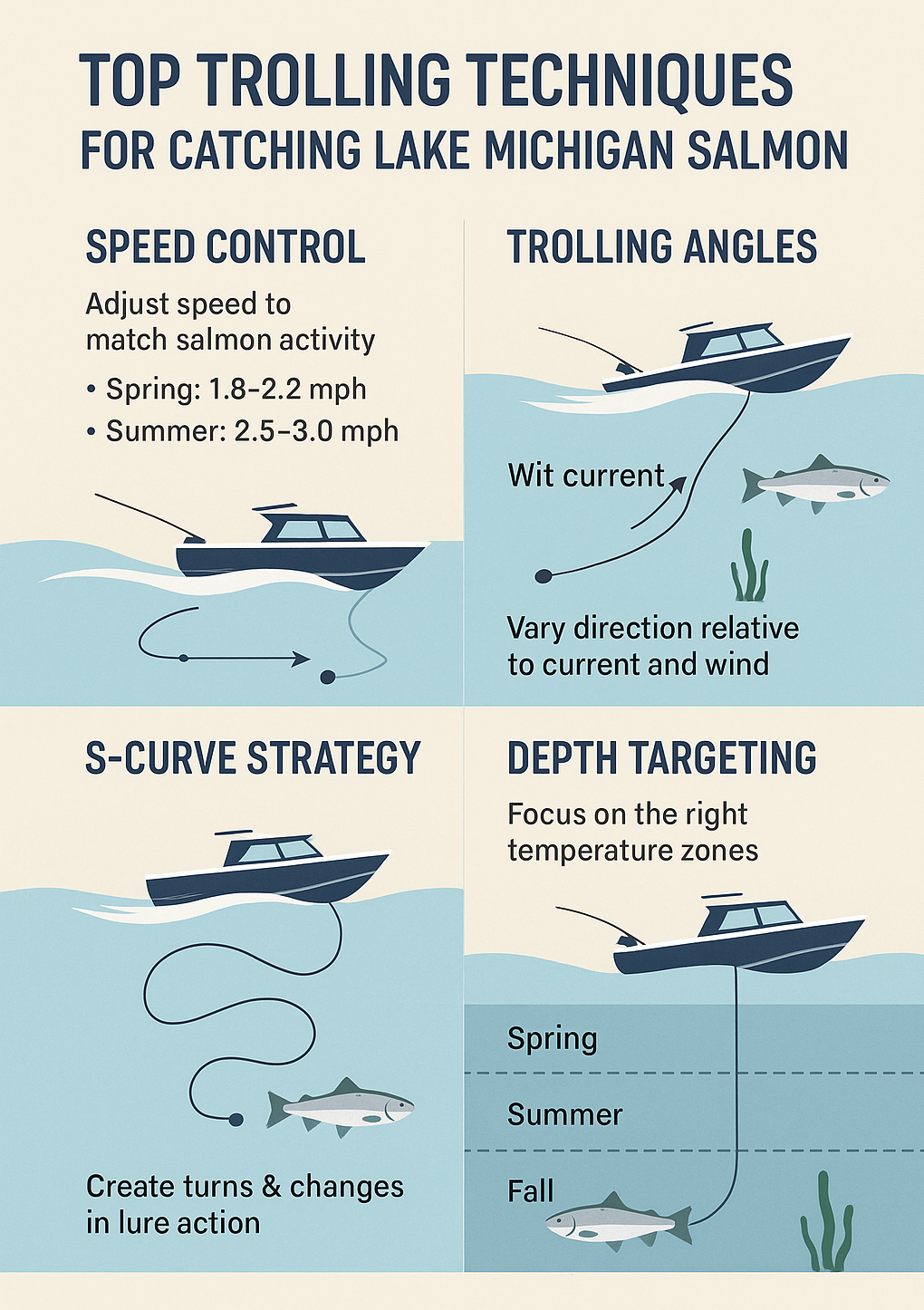 If you’re planning a salmon fishing charter on Lake Michigan out of the scenic port of Saugatuck, you’re in for an unforgettable experience. Whether you’re a seasoned angler or casting lines for the first time, one of the key techniques we use to chase down monster Kings and Coho salmon is trolling. Trolling is the gold standard for salmon fishing on Lake Michigan — and it’s more strategic than you might think.
If you’re planning a salmon fishing charter on Lake Michigan out of the scenic port of Saugatuck, you’re in for an unforgettable experience. Whether you’re a seasoned angler or casting lines for the first time, one of the key techniques we use to chase down monster Kings and Coho salmon is trolling. Trolling is the gold standard for salmon fishing on Lake Michigan — and it’s more strategic than you might think.
Here’s a breakdown of the top trolling techniques we use on our charters and what you can expect to see (and catch!) when you come aboard.
Speed Control: The Art of the Perfect Pace
Speed can make or break a trolling run. Salmon are fast, reactive predators, and our trolling speed has to match their mood.
- In early spring, when water temperatures are cold and salmon are less aggressive, we slow down to around 1.8–2.2 mph.
- As the water warms up in mid to late summer, we often bump up to 2.5–3.0 mph to entice more active fish.
You’ll notice that we’re constantly adjusting our speed — often by small increments — because even a change of 0.2 mph can be the difference between a quiet rod and a screaming reel.
We’ll often watch how the lures are working in the spread or use a downrigger-mounted probe to monitor speed at depth, where the salmon actually are. What feels like 2.5 mph on the surface can be much slower 50 feet down due to current.
Trolling Angles: It’s Not Always Straight Ahead
Salmon aren’t always going to chase bait head-on, which is why we don’t troll in a straight line all day. Changing our trolling direction relative to current and wind is crucial. Angling the boat:
- With the current can keep our lures moving more slowly through the water column.
- Against the current can add extra action to the lures.
- Cross-current or diagonal trolling often hits the sweet spot, mimicking a wounded baitfish trying to escape.
When a rod fires, we take note of the boat’s angle at that exact moment. Repeating productive passes at that same angle often brings in more fish.
The S-Curve Strategy: Triggering Reaction Strikes
One of the most reliable trolling patterns we use is the S-curve. Instead of driving the boat in a straight line, we make slow, sweeping curves — picture the shape of a lazy “S” across the water.
Why it works:
- The inside lures momentarily slow down during the turn.
- The outside lures speed up and rise slightly.
- This variation in action often triggers salmon into striking, especially those that have been following but haven’t committed yet.
On your charter, you’ll see this in action — especially during slow periods. It’s amazing how a simple boat turn can suddenly light up the rods.
Depth Targeting: Finding the Right Water Column
Salmon are temperature-sensitive and depth-driven. To be successful, we have to present lures in the exact zone they’re feeding.
- In spring, we often target water less than 30 feet deep, near the shoreline or river mouths, where Coho salmon and immature Kings hunt.
- By summer, thermal layers (thermoclines) develop, and mature Kings go deep — often 60 to 100 feet down, sometimes even deeper on hot August days.
- In fall, pre-spawn salmon stage in mid-depths, and we’ll run a wide spread to cover 20 to 80 feet and key in on patterns.
We use a combination of downriggers, dipsy divers, copper lines, and copper line to present lures at multiple depths. You’ll see your captain and crew working the rods constantly — adjusting, resetting, and fine-tuning based on fish marks on the sonar or how each rod is performing.
How These Techniques Change Through the Season
Every season on Lake Michigan offers a unique salmon-fishing experience:
- April–May: Nearshore trolling for aggressive Coho and steelhead. Flat lines, high-speed dodgers, and bright spoons.
- June–July: Kings move deeper. More sophisticated spreads with longer leads, flasher/fly combos, and a focus on depth control.
- August: Trophy time. Big mature Chinook push offshore and deep. Patience, persistence, and sharp trolling technique matter most.
- September: Staging salmon come in closer again before spawning. Surface temperatures drop, and we adjust to more erratic bite windows.
As your charter captain, we bring local knowledge and experience to these seasonal shifts — so no matter when you book, we’ll be using the most productive approach for that time of year.
Get Hooked on the Experience
When you book a salmon charter out of Saugatuck, you’re not just going fishing — you’re joining a tactical hunt across one of the Great Lakes’ richest fisheries. Every rod spread, every boat turn, and every speed adjustment is part of the strategy. And nothing beats the thrill of watching a rod slam down, drag screaming, and knowing you’ve got a Lake Michigan salmon on the other end.
Whether you’re after your first King or chasing a personal-best catch, you’ll walk away with an unforgettable story — and likely some fresh fillets too.
Ready to experience it for yourself? Book your Saugatuck salmon charter today and join us on the water. Tight lines!
